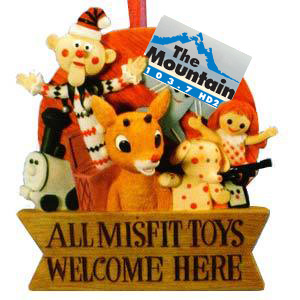 I’m starting to think that HD Radio sub channels are turning into the land of misfit formats.
I’m starting to think that HD Radio sub channels are turning into the land of misfit formats.
Last Friday Seattle’s 22 year-old Adult Album Alternative station The Mountain 103.7 FM flipped to the Hot Adult Contemporary format with nearly no notice from Entercom, its owner. But instead of disappearing, The Mountain’s format lives on as an HD2 channel on the same frequency, in addition to an online stream.
A couple of weeks ago Jennifer reported that Knox College’s student-run WVKC will give over its main analog frequency to Tri States Public Radio. In exchange WVKC will take over an HD2 channel and also go online. Something similar happened to Vanderbilt University’s student-run WRVU in 2011. The station is now primarily online, but also heard on an HD3 channel.
If a station has already invested in an HD transmitter then the cost of shifting a killed format to an HD2 channel is minuscule, especially if only the music, and not the air staff, make the move. But it gives the appearance that the station isn’t totally abandoning the old formats loyal listeners, even if it is actually abandoning those 99% of listeners who don’t have an HD receiver. Giving the HD2 to students booted off the main analog channel is also low-cost, but makes the new owners look magnanimous compared to giving the students nothing.
Aside from the possible PR boost, one has to wonder what the more tangible advantages are to shifting unwanted formats to HD sub channels.
In a recent column by Bob Struble, CEO of iBiquity which owns HD Radio technology, wrote that he sees “immediate” return-on-investment for stations that use an HD2 signal to feed a translator repeater station. The FCC recently ruled that translators, which for commercial stations are are intended to help fill-in areas with poor reception, can be used to rebroadcast a station’s HD2 and HD3 channels, not just the main analog/HD1 channel.
As Struble put it, “In effect, it’s like getting another unique analog FM signal for a tiny fraction of the cost of a new station. Get that translator’s antenna up high enough, and it’s basically a new Class A for the cost of the HD Radio upgrade.”
Of course, that’s sort of tantamount to admitting that HD-only channels aren’t really worth that much in terms of listenership. That’s despite how much Struble touts sales figures showing 50% annual growth 2010–2013 in HD receivers, driven almost entirely by the auto market. He claims 30% of new cars will have integrated HD radios in 2013. However, there are still only about 15 million HD-capable radios in the US right now. And tuning in an HD2 or HD3 channel in a car moving 55 MPH isn’t always as easy as just hitting the seek button.
If Entercom wants to put The Mountain on a translator in the Seattle area, then maybe the station will live on for the majority of its former listeners. Same thing for Knox’s WVKC, only the students are at the mercy of Tri States Public Radio, which I’m guessing would not be interested in even giving up a translator to the student DJs.
Otherwise I continue to think that giving an HD2 or HD3 channel to a station or format bumped off its main analog/HD1 channel is like giving them a year’s supply of Rice-A-Roni–a consolation prize that might look good on paper, but amounts to little more than something very few want to consume.
Being consigned to an HD2 or HD3 is being sent off to the land of misfit formats.


